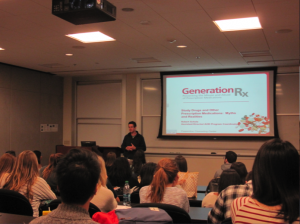When talking about the dangers of drugs, few consider the neatly packaged pills prescribed by doctors across the country. In fact, more Americans die every year from using prescriptions bought in a pharmacy than drugs bought on the street.
In an attempt to “increase knowledge about risks of taking commonly abused prescription drugs,” Assistant Director of the Counseling Center Robert Scholz addressed the crowd on Wednesday for a Convocation event titled: “Drugged: Prescription Drug Abuse Among College Students.”

Fire codes prevented some students from attending the crowded Convocation session in Plaza Classroom 190, yet the congregation remained relatively hushed as they waited for Scholz to approach the front of the class.
“There is an overall perception among teenagers that you can’t be harmed as much by prescription drugs as you can be harmed by coke or something like that,” Scholz said. “This is an issue we haven’t talked a lot about. It’s one of those topics we’re afraid to look at because it’s so common for people to use prescription drugs.”
“Prescription drug abuse causes the largest percentage of deaths from drug overdosing,” Scholz wrote in an email. “More than heroin, methamphetamine and cocaine combined.”
Part of the problem is the way society views prescription drugs as relatively safe.
“I think the reason why this has become such a problem is that pills have become the norm,” Scholz said. “Sometimes in a college setting, when people offer pills or provide pills, we don’t think anything of it. And yet I can tell you story after story of people who ended up in the ER or had a psychotic reaction to taking somebody else’s medication.
“They had no idea what they were taking when they popped it in their mouth,” Scholz said.
Scholz said 10 to 15 percent of college students use prescription drugs that are not prescribed to them. That is a huge increase since the early 2000s, when only 2 to 3 percent did so.
“We’ve seen a rapid increase in prescription drug abuse among teenagers and young adults over the past 20 years,” Scholz said. “Unintentional drug poisoning is the second leading cause of accidental deaths.”
Scholz said the culture of alcoholism on college campuses adds to the risk, referencing an article by the national council of patient information and education “Educate Before You Medicate.”
“The article wrote, ‘It’s a perfect Storm — Roughly half (49 percent) of all college students binge drink and a growing number report misusing or abusing prescription drugs (NCASA, 2007),’” Scholz wrote in an email. “‘Taking these substances together or with other illicit drugs can quickly spell trouble, leading to dangerous interaction, possible overdose and death.’”
Many of the cases of overdose among college students are the result of painkillers such as Vicodin, sedatives such as Xanax and stimulants such as Adderall. Scholz warned against mixing these drugs with each other, as well as with energy drinks or alcohol.
“Mixing medications — don’t do it,” Scholz said. “Bottom line. We see more and more ER runs are the result of mixing energy drinks and alcohol or stimulants and alcohol.”
Freshman Hayden Paulsen said the event reminded him of the power of drugs — prescription or otherwise.
“We are under a lot of pressure,” Paulsen said. “Everything from grad school, to jobs, to social lives, to sleep, to health is always on our minds. A stress relief or ability booster in pill form is a miracle for a lot of college students. How easy it is to play the system to get prescription drugs that have the ability to really harm your body and others by giving them away. Once you have them, it’s only natural to want to spread such powerful pills.”
Freshman Cassandra Claudio said that while some of the information in the presentation was common knowledge, it gave her a better basic understanding of the dangers of prescription drug abuse.
“It enhanced what I already knew,” Claudio said. “It gave me more knowledge on the basics.”
———————————————————————————————————————
Follow Nate Barton on Twitter: @TheNateBarton

